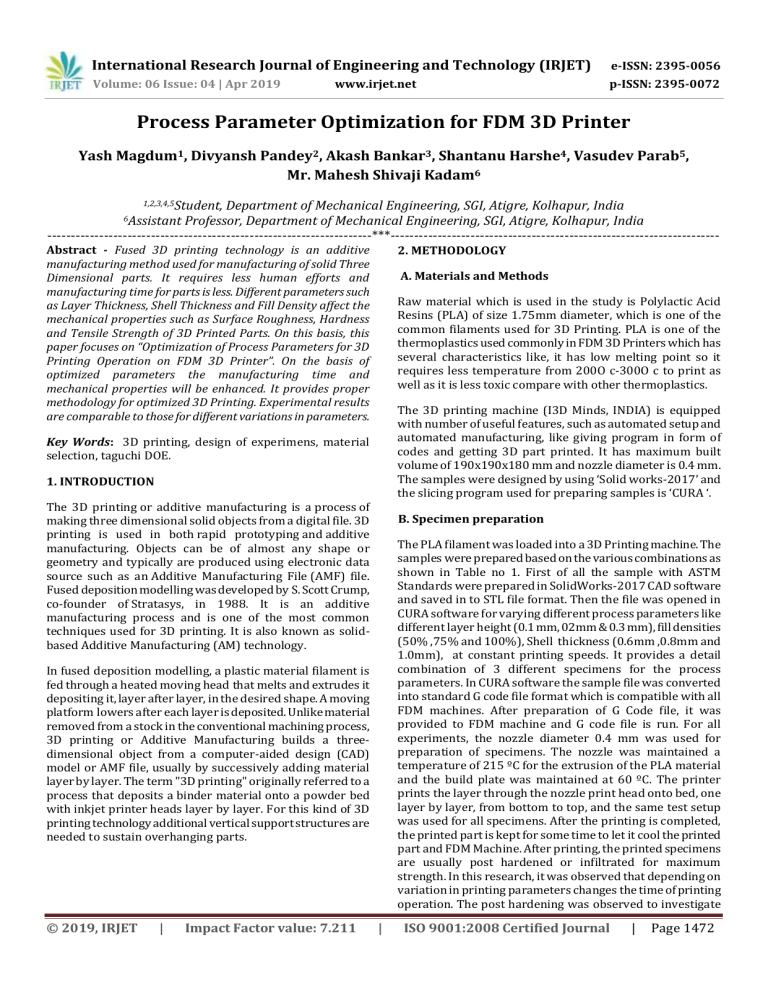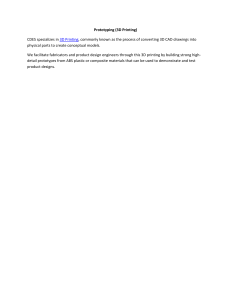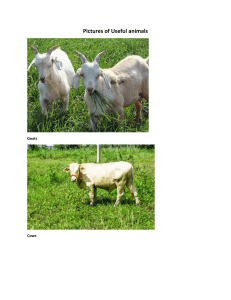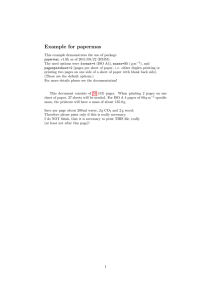
International Research Journal of Engineering and Technology (IRJET)
e-ISSN: 2395-0056
Volume: 06 Issue: 04 | Apr 2019
p-ISSN: 2395-0072
www.irjet.net
Process Parameter Optimization for FDM 3D Printer
Yash Magdum1, Divyansh Pandey2, Akash Bankar3, Shantanu Harshe4, Vasudev Parab5,
Mr. Mahesh Shivaji Kadam6
1,2,3,4,5Student,
Department of Mechanical Engineering, SGI, Atigre, Kolhapur, India
Professor, Department of Mechanical Engineering, SGI, Atigre, Kolhapur, India
---------------------------------------------------------------------***---------------------------------------------------------------------6Assistant
Abstract - Fused 3D printing technology is an additive
manufacturing method used for manufacturing of solid Three
Dimensional parts. It requires less human efforts and
manufacturing time for parts is less. Different parameters such
as Layer Thickness, Shell Thickness and Fill Density affect the
mechanical properties such as Surface Roughness, Hardness
and Tensile Strength of 3D Printed Parts. On this basis, this
paper focuses on “Optimization of Process Parameters for 3D
Printing Operation on FDM 3D Printer”. On the basis of
optimized parameters the manufacturing time and
mechanical properties will be enhanced. It provides proper
methodology for optimized 3D Printing. Experimental results
are comparable to those for different variations in parameters.
2. METHODOLOGY
A. Materials and Methods
Raw material which is used in the study is Polylactic Acid
Resins (PLA) of size 1.75mm diameter, which is one of the
common filaments used for 3D Printing. PLA is one of the
thermoplastics used commonly in FDM 3D Printers which has
several characteristics like, it has low melting point so it
requires less temperature from 200O c-300O c to print as
well as it is less toxic compare with other thermoplastics.
The 3D printing machine (I3D Minds, INDIA) is equipped
with number of useful features, such as automated setup and
automated manufacturing, like giving program in form of
codes and getting 3D part printed. It has maximum built
volume of 190x190x180 mm and nozzle diameter is 0.4 mm.
The samples were designed by using ‘Solid works-2017’ and
the slicing program used for preparing samples is ‘CURA ‘.
Key Words: 3D printing, design of experimens, material
selection, taguchi DOE.
1. INTRODUCTION
The 3D printing or additive manufacturing is a process of
making three dimensional solid objects from a digital file. 3D
printing is used in both rapid prototyping and additive
manufacturing. Objects can be of almost any shape or
geometry and typically are produced using electronic data
source such as an Additive Manufacturing File (AMF) file.
Fused deposition modelling was developed by S. Scott Crump,
co-founder of Stratasys, in 1988. It is an additive
manufacturing process and is one of the most common
techniques used for 3D printing. It is also known as solidbased Additive Manufacturing (AM) technology.
B. Specimen preparation
The PLA filament was loaded into a 3D Printing machine. The
samples were prepared based on the various combinations as
shown in Table no 1. First of all the sample with ASTM
Standards were prepared in SolidWorks-2017 CAD software
and saved in to STL file format. Then the file was opened in
CURA software for varying different process parameters like
different layer height (0.1 mm, 02mm & 0.3 mm), fill densities
(50% ,75% and 100%), Shell thickness (0.6mm ,0.8mm and
1.0mm), at constant printing speeds. It provides a detail
combination of 3 different specimens for the process
parameters. In CURA software the sample file was converted
into standard G code file format which is compatible with all
FDM machines. After preparation of G Code file, it was
provided to FDM machine and G code file is run. For all
experiments, the nozzle diameter 0.4 mm was used for
preparation of specimens. The nozzle was maintained a
temperature of 215 ºC for the extrusion of the PLA material
and the build plate was maintained at 60 ºC. The printer
prints the layer through the nozzle print head onto bed, one
layer by layer, from bottom to top, and the same test setup
was used for all specimens. After the printing is completed,
the printed part is kept for some time to let it cool the printed
part and FDM Machine. After printing, the printed specimens
are usually post hardened or infiltrated for maximum
strength. In this research, it was observed that depending on
variation in printing parameters changes the time of printing
operation. The post hardening was observed to investigate
In fused deposition modelling, a plastic material filament is
fed through a heated moving head that melts and extrudes it
depositing it, layer after layer, in the desired shape. A moving
platform lowers after each layer is deposited. Unlike material
removed from a stock in the conventional machining process,
3D printing or Additive Manufacturing builds a threedimensional object from a computer-aided design (CAD)
model or AMF file, usually by successively adding material
layer by layer. The term "3D printing" originally referred to a
process that deposits a binder material onto a powder bed
with inkjet printer heads layer by layer. For this kind of 3D
printing technology additional vertical support structures are
needed to sustain overhanging parts.
© 2019, IRJET
|
Impact Factor value: 7.211
|
ISO 9001:2008 Certified Journal
|
Page 1472
International Research Journal of Engineering and Technology (IRJET)
e-ISSN: 2395-0056
Volume: 06 Issue: 04 | Apr 2019
p-ISSN: 2395-0072
www.irjet.net
the unconditional effect of printing parameters on physical
and mechanical properties of the printed specimens.
4. Manufacturing Process
A.
Modeling
Table -1: Specimen printing parameter variations.
Specimen
Density
Layer
Height
Shell Thickness
1
50
0.1
0.6
2
50
0.2
0.8
3
50
0.3
1.0
4
75
0.1
1.0
5
75
0.2
0.8
6
75
0.3
0.6
7
100
0.1
0.8
8
100
0.2
1.0
9
100
0.3
0.6
3. Discussion:
Fig. 1 Cad modeling
A. Different process parameters of specimens:
3D printable models may be created with a computer-aided
design (CAD) package, via a 3D scanner, or by a plain digital
camera and photogrammetry software. 3D printed models
created with CAD result in reduced errors and can be
corrected before printing, allowing verification in the design
of the object before it is printed. The manual modelling
process of preparing geometric data for 3D computer
graphics is similar to plastic arts such as sculpting. 3D
scanning is a process of collecting digital data on the shape
and appearance of a real object, creating a digital model
based on it.
Layer height (mm):
As this additive manufacturing method uses layer by layer
printing, the Layer Height Parameter plays an important role
in variation in mechanical as well as physical properties.
Layer Height varies from 0.06 to 0.4mm for 0.4mm diameter
nozzle.
Shell thickness (mm):
The shell thickness is the thickness of outer shell of the part.
This is used in combination with the fill density which is
selected for printing to increase the mechanical as well as
physical properties.
B. Printing
Infill density (%):
It is the density of the part which is to be printed. For a solid
part use 100% and for an empty part use 0% fill ensity. A
value around 20 is usually enough. This won’t affect the
outside of the print and adjusts how strong the part
becomes.
Printing speed (mm/s):
Printing speed is the speed at which printing happens by the
movement of printing head. A well-adjusted printer can
reach 150mm/s, but for good quality prints it need to print
slower. Printing speed depends on lot of B. Self-supportingbased strategy
© 2019, IRJET
|
Impact Factor value: 7.211
Fig -2: Specimens Manufacturing
Before printing a 3D model from an STL file, it must first be
examined for errors. Most CAD applications produce errors
in output STL files, of the following types:
|
1.
Holes;
2.
Faces normal;
3.
Self-intersections;
ISO 9001:2008 Certified Journal
|
Page 1473
International Research Journal of Engineering and Technology (IRJET)
e-ISSN: 2395-0056
Volume: 06 Issue: 04 | Apr 2019
p-ISSN: 2395-0072
www.irjet.net
4.
Noise shells;
For maximization of Tensile Strength.
5.
Manifold errors.
For maximization of Strength (Hardness).
For Larger -the-Better
A step in the STL generation known as "repair" fixes such
problems in the original model. Generally STLs that have
been produced from a model obtained through 3D
scanning often have more of these errors. This is due to how
3D scanning works-as it is often by point to point acquisition,
reconstruction will include errors in most cases.
C.
S/FL=-10log10 [⅀ (1/y2)/n]
Finishing
For minimization of Surface Roughness
For Smaller-the-Better
S/FS=-10log10 [(⅀y2)/n]
Table -2: No. of parameters and levels.
Factors
Levels
1
2
3
Fill Density
50
75
100
Layer Thickness
0.1
0.2
0.3
Shell Thickness
0.6
0.8
1.0
Table -3: Experiment no. and Control Factors.
Fig-3: Finishing of specimen
Experiment
No.
1
2
3
4
5
6
7
8
9
Though the printer-produced resolution is sufficient for many
applications, printing a slightly oversized version of the
desired object in standard resolution and then removing
material with a higher-resolution subtractive process can
achieve greater precision.
5. Design of Experiments.
A. Taguchi DOE:
Taguchi design, or an orthogonal array, is a method of
designing experiments that usually requires only a fraction of
the full factorial combinations. An orthogonal array means
the design is balanced so that factor levels are weighted
equally. Because of this, each factor can be evaluated
independently of all the other factors, so the effect of one
factor does not influence the estimation of another factor.
Dr.Genichi Taguchi is regarded as the foremost proponent of
robust parameter design, which is an engineering method for
product or process design that focuses on minimizing
variation and/or sensitivity to noise.
Control Factors
A
B
1
1
1
2
1
3
2
1
2
2
2
3
3
1
3
2
3
3
C
1
2
3
3
1
2
2
3
1
6. Testing Techniques
A. Tensile Test
B. Taguchi Method
In the optimization of 3D printer there are THREE
Parameters (Factors) THREE Levels.
For Full Factorial method the number of
experiments is 27.
For Taguchi Method for THREE factors THREE
levels.
© 2019, IRJET
|
Impact Factor value: 7.211
Fig-4: Universal Testing Machine
|
ISO 9001:2008 Certified Journal
|
Page 1474
International Research Journal of Engineering and Technology (IRJET)
e-ISSN: 2395-0056
Volume: 06 Issue: 04 | Apr 2019
p-ISSN: 2395-0072
www.irjet.net
A universal testing machine (UTM), also known as a universal
tester, materials testing machine or materials test frame, is
used
to test
the tensile
strength and compressive
strength of materials. An earlier name for a tensile testing
machine is a tensometer. The "universal" part of the name
reflects that it can perform many standard tensile and
compression tests on materials, components, and structures
(in other words, that it is versatile).
B. Hardness Test
Components:
Several variations are in use. Common components include:
Fig-5: Shore-A Durometer.
Load frame - Usually consisting of two strong
supports for the machine. Some small machines have
a single support.
The Shore Durometer is a device for measuring
the hardness of a material, typically of polymers, elastomers,
and rubbers
Load cell - A force transducer or other means of
measuring
the
load
is
required.
Periodic calibration is usually required by governing
regulations or quality system.
Higher numbers on the scale indicate a greater resistance to
indentation and thus harder materials. Lower numbers
indicate less resistance and softer materials.
Cross head - A movable cross head (crosshead) is
controlled to move up or down. Usually this is at a
constant speed: sometimes called a constant rate of
extension (CRE) machine. Some machines can
program the crosshead speed or conduct cyclical
testing, testing at constant force, testing at constant
deformation, etc. Electromechanical, servohydraulic, linear drive, and resonance drive are used.
The term is also used to describe a material's rating on the
scale, as in an object having a “‘Shore Durometer’ of 90.”
The scale was defined by Albert Ferdinand Shore, who
developed a suitable device to measure hardness in the
1920s. It was neither the first hardness tester nor the first to
be called a Durometer (ISV duro- and -meter; attested since
the 19th century), but today that name usually refers to Shore
hardness; other devices use other measures, which return
corresponding results, such as for Rockwell hardness.
Means of measuring extension or deformation - Many tests
require a measure of the response of the test specimen to the
movement of the cross head. Extensometers are sometimes
used.
4.2.1
Mititoyo SJ-210
Output device - A means of providing the test result is
needed. Some older machines have dial or digital displays
and chart recorders. Many newer machines have a computer
interface for analysis and printing.
Conditioning - Many tests require controlled conditioning
(temperature, humidity, pressure, etc.). The machine can be
in a controlled room or a special environmental chamber can
be placed around the test specimen for the test.
Test fixtures, specimen holding jaws, and related sample
making equipment are called for in many test methods.
Fig-6: Surface Roughness Test
© 2019, IRJET
|
Impact Factor value: 7.211
|
ISO 9001:2008 Certified Journal
|
Page 1475
International Research Journal of Engineering and Technology (IRJET)
e-ISSN: 2395-0056
Volume: 06 Issue: 04 | Apr 2019
p-ISSN: 2395-0072
www.irjet.net
techniques, Additive Manufacturing, (2018), (Pg.243255).
FEATURES
• The 2.4-inch colour graphic LCD provides excellent
readability and an intuitive display that is easy to use. The
LCD also includes a backlight for improved visibility in dark
environments.
[4]
Barry Berman, 3-D printing: The new industrial
revolution, Kelley School of Business, Indiana University.
All rights reserved, (2011) (Pg.155-162).
[5]
Wei Dai Vian, PhD and Nancy L. Denton, Hardness
Comparison of Polymer Specimens Produced with
Different Processes , PE School of Engineering
Technology Purdue University Kokomo and West
Lafayette, Indiana, (2015) (Pg.1312-1314).
[6]
Wenyong Liu, Ying Li, Jinyu Liu, Xufeng Niu, Yu Wang
and Deyu Li, Application and Performance of 3D Printing
in Nanobiomaterials, Key Laboratory for Biomechanic
sand Mechanobiology of Ministry of Education, School of
Biological Science and Medical Engineering,
BeihangUniversity,Beijing100191,China, (2014)(Pg.1-7)
[7]
Nathaniel Hudson1, Celena Alcock2, Parmit K. Chilana1,
Understanding Newcomers to 3D Printing: Motivations,
Workflows, and Barriers of Casual Makers ,
1Management Sciences University of Waterloo
Waterloo, ON Canada {ndphudso, pchilana} 2Drama and
Speech Communication University of Waterloo
Waterloo, ON Canada(2016)(Pg. 384-396)
[8]
Yingying Xuea, Xinfu Wanga, Wen Wanga, Xiaokang
Zhonga, Fusheng Hana,Compressive property of Albased auxetic lattice structures fabricated by 3D
printing combined with investment casting, aKey
Laboratory of Materials Physics, Institute of Solid State
Physics, Chinese Academy of Sciences, Hefei, Anhui
230031, China bUniversity of Science and Technology of
China, Hefei, Anhui 230026, China(2018)(255-262)
[9]
Chelsea
Schelly,
GeraldAnzalone,
BasWijnen,
JoshuaM.Pearce , Open-source 3-D printing technologies
for education: Bringing additive manufacturing to the
classroom,(2015)(Pg. 1-12)
[10]
Elizabeth Matias, Bharat Rao, 3D Printing: On Its
Historical Evolution and the Implications for Business,
PICMET '15: Management of the Technology Age ,(2015)
(Pg.551-558)
Nadim S. Hmeidat, James W. Kemp, Brett G. Compton,
High-strength epoxy nanocomposites for 3D printing,
Mechanical, Aerospace, and Biomedical Engineering
Department University of Tennessee, Knoxville
Knoxville, TN 37996 USA, (2018)(1-36)
[11]
Dina R. Howeidy , The Impact of Using 3D Printing on
Model Making Quality and Cost in the Architectural
Design Projects, International Journal of Applied
Engineering Research ISSN 0973-4562 Volume 12,
(2017) (pg.987-994).
Wei Dai Vian, PhD and Nancy L. Denton, Hardness
Comparison of Polymer Specimens Produced with
Different Processes, School of Engineering Technology
Purdue University Kokomo and West Lafayette, Indiana,
(2018)
[12]
Daniel Farbman, Material Testing of 3D Printed ABS and
PLA Samples To Guide Mechanical Design, University of
California, Berkeley Berkeley, California, United States of
America, (2017)(1-12)
• The Mititoyo SJ-210 can be easily operated using the
buttons on the front of the unit and under the sliding cover.
• Up to 10 measurement conditions and one measured profile
can be stored in the internal memory.
• An optional memory card can be used as an extended
memory to store large quantities of measured profiles and
conditions. Access to each feature can be password protected
which prevents unintended operations and allows you to
protect your settings.
• The display interface supports 16 languages, which can be
freely switched.
• An alarm warns you when the cumulative measurement
distance exceeds a preset limit.
• The Mititoyo SJ-210 complies with the following standards:
JIS (JIS-B0601-2001,
JIS-B0601-1994, JIS B0601-1982), VDA, ISO-1997 and ANSI.
• In addition to calculation results, the Mititoyo SJ-210 can
display sectional calculation results and assessed profiles,
load curves, and amplitude distribution curves.
7. CONCLUSION
On the basis of varying different parameters in different level
a Design of Experiments are carried out which can be used
for preparation of specimens for optimization of 3D printed
products for different parameters of 3D printing. Testing
machines are selected for testing mechanical properties such
as Tensile strength, Hardness and Surface Roughness of 3D
printed specimens.
REFERENCES
[1]
[2]
[3]
Mamta Junejaa, Niharika Thakura, Dinesh Kumara,
Ankur Guptab, Babandeep Bajwac, Accuracy in dental
surgical guide fabrication using different 3-D printing
© 2019, IRJET
|
Impact Factor value: 7.211
|
ISO 9001:2008 Certified Journal
|
Page 1476
International Research Journal of Engineering and Technology (IRJET)
e-ISSN: 2395-0056
Volume: 06 Issue: 04 | Apr 2019
p-ISSN: 2395-0072
www.irjet.net
BIOGRAPHIES
Y D. Magdum, pursuing B.E degree
in Mechanical Engineering from
Shivaji University, Kolhapur, India,
in 2018.
D L. Pandey, pursuing B.E degree
in Mechanical Engineering from
Shivaji University, Kolhapur, India,
in 2018.
A S. Bankar, pursuing B.E degree in
Mechanical Engineering from
Shivaji University, Kolhapur, India,
in 2018.
S S. Harshe, pursuing B.E degree in
Mechanical Engineering from
Shivaji University, Kolhapur, India,
in 2018.
V A. Parab, pursuing B.E degree in
Mechanical Engineering from
Shivaji University, Kolhapur, India,
in 2018.
M S. Kadam, received M.E Degree
in Mechanical engineering from
KIT College of Engineering,
Kolhapur, India 2014 and He is
currently pursuing the Ph.d Degree
in mechanical engineering at
Shivaji University From 2016, he is
assistant professor at Sanjay
Ghodawat College of engineering.
And his research area is Nano
Composite and other research
interest is Finite Element Analysis.
© 2019, IRJET
|
Impact Factor value: 7.211
|
ISO 9001:2008 Certified Journal
|
Page 1477




